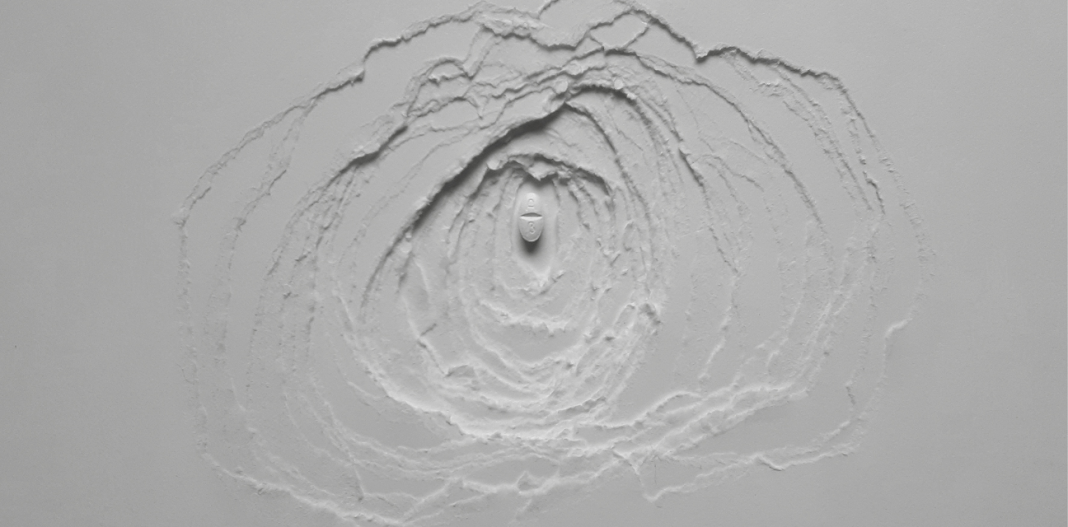Artwork: Kurt von Bley
In a tight-knit community like Berlin’s techno scene, keeping a secret is virtually impossible. Especially, of course, when you quickly become one of the most talked about institutions in town. STAUB started as a monthly party at ://about:blank in early 2013 and became one of Berlin’s unlikeliest success stories. With its strict policy of not announcing the line-ups before and sticking to its running time between late Saturday morning and 10pm in the evening, it was perhaps too niche to fail – the word started spreading quickly, the queues grew bigger and bigger. Even though some of the figures behind the series are known these days and some bigger names seem to return for STAUB’s sweaty afternoon raves, their audience seems either not to care about what expects them on the two ://about:blank floors – and, in summer, the garden – or is drawn to them exactly because of that. For their forthcoming 22-hour long five-year anniversary party on February 23rd however, we caught up with some of the people behind STAUB and present their exclusive contribution to our Groove podcast.
STAUB normally runs on Saturdays between 10am and 10pm, but can hardly be qualified as an afterhour. Why did you choose this unusual time?
://about:blank offered us that time first. It was not easy to make something interesting and to get enough people. So that’s why we came up with this idea of STAUB to keep everything more intimate and not to focus on names or fame, but music and atmosphere. Also there was not that many opportunities back then to hear techno on Saturdays during daytime in Berlin.
In its five years, STAUB has become a fixture in the Berlin clubbing scene, yet only occasionally hosts longer parties. Why do you usually stick to the ten-hour format?
To keep an intense and good atmosphere for a long time is not easy. All of our team members try to be at the party all the time, to observe and see what’s going on, take care of our guests and artists properly. This is more difficult when you do a 24-hour long party. We do longer formats only for special occasions like the birthdays of George Orwell, Floyd Mayweather Jr., Wilhelm Grimm or the death of Tolstoi.
With recent events in Denmark, at Institut fuer Zukunft or Hamburg’s P.A.L., STAUB has expanded its scope. How did the concept translate in cities other than Berlin and what made you take this step in the first place?
We got these requests from different clubs and promoters, they like the spirit of the party. It’s not about one or two resident DJs playing somewhere else, it’s also kind of a social thing. We arrive with the crew and try to create a special atmosphere. We have to feel a connection!
While some of the resident DJs aren’t exactly a secret anymore, STAUB still sticks to its no line-up policy. What are your main priorities when it comes to booking and programming the series?
This is not only about residents, the surprise factor is important. Sometimes things come together without forcing it too much, some our favorite DJs are in town, or there is special concept for one floor, or we try out something new. It is also an opportunity to present completely unknown artists and give them a chance, which we think is very important.
During summer, STAUB also invites DJs to play in the ://about:blank garden, with sets ranging from experimental music to the Depeche Mode-only. How does that fit into the general concept of STAUB?
It’s all about diversity. Music also has different colors and shades. STAUB is a techno party, but we hope it can help discover new things. Maybe because the line-up is not public, artists can get out of their confort zone more easily. For example Cio D’or playing a breakbeat, Asian-influenced set, or Air Liquide playing ambient. I think we are very lucky to have regular guests that are open-minded and not just expect banging techno all the time.
In 2016, you have started a compilation series on STAUB mainstay’s I/Y’s own label with a third instalment set for a release to coincide with the five-year anniversary. How exactly are the events connected with the – also anonymous – series?
For this series, we asked artists who already performed at STAUB to send us music which they feel represent the party. What we try to do with the records is what we aim to do with the party: put the focus on music, be diverse, and surprise people.
Your contribution to our Groove podcast kicks off with a track from STAUB 002 and includes a new tune from the forthcoming compilation as well. What was your idea behind it?
We tried to capture a moment, a glimpse of the atmosphere and the sound of STAUB.
What are the plans for the STAUB series in the near future?
The state of our civilization is alarming and it is difficult to envision the future. We will try to play a small part and contribute to humanity with music, parties and many other artefacts.
Stream: STAUB – Groove Podcast 146
01. Unknown Arist – A1 STAUB 002
02. Sam Kdc – Graven Image
03. Mondkopf – You Were Too Proud
04. Valura – Exalted Encounter (Lag Remix)
05. Surgeon – Convenience Trap pt.2
06. O/V/R – Except In Dreams
07. PAS – function 6 (Kamikaze Space Programme Remix)
08. Zadig – Inlandsis
09. Exium & Reeko – Circuit IV
10. Unknown Artist – B1 STAUB 003
11. Mekas – Unknown Soldier
12. Synthek – Uneven Mind
13. Boy Harsher – Lust





